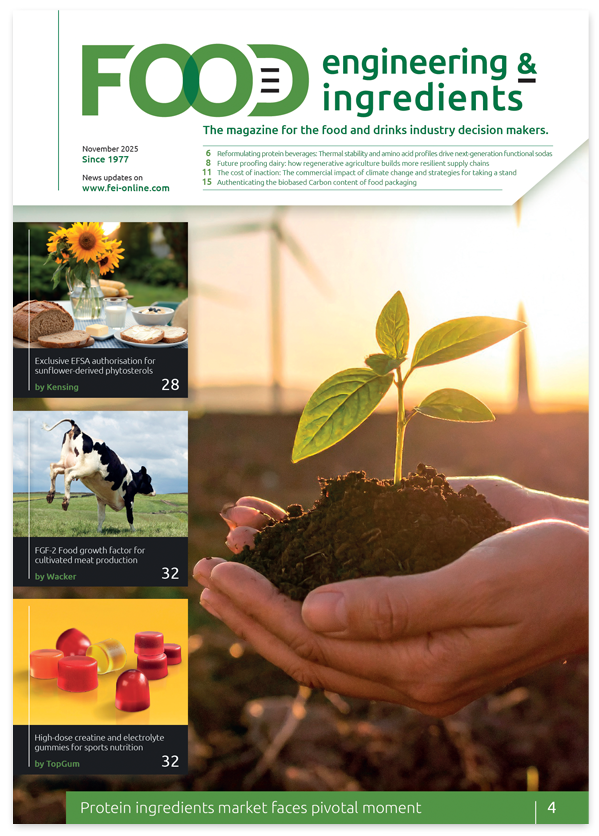Probiotics: A comprehensive look at their evolution and market trends
From ancient Bulgarian yogurt to cutting-edge infant nutrition, the developing world of probiotics continues to reshape our understanding of gut health. Mahalakshmi, research associate at Giract, explores the latest trends, regulatory challenges, and breakthrough developments in the global probiotics industry, with particular focus on European markets and recent product innovations.

Mahalakshmi
Introduction
Probiotics are live microorganisms that, when administered in adequate amounts, confer a health benefit on the host. First brought to the spotlight in the early 20th century by Russian Nobel laureate Elie Metchnikoff, probiotics gained significant attention when he linked the longevity of Bulgarian villagers to their consumption of a fermented yoghurt drink containing Lactobacillus bulgaricus. Inspired by this discovery, Japanese microbiologist Dr Minoru Shirota discovered Lactobacillus casei Shirota and introduced the yoghurt drink Yakult in 1935, which became globally recognized for its gut health benefits.
Probiotic cultures predominantly come from two genera: Lactobacillus and Bifidobacterium, which account for over 90% of the total probiotic strains available by volume. However, other genera such as Bacillus, Lactococcus, Enterococcus, Pediococcus, Streptococcus, and Saccharomyces are also used in developing certain probiotic products.
Probiotics and their health implications
Research has shown that a balanced gut microbiome is crucial for overall health, impacting gastrointestinal and autoimmune disorders and potentially reducing the risk of stomach cancer. Probiotics are widely used for various health benefits, with gut health remaining the primary focus.
The probiotic content in a product is quantified using colony-forming units (CFUs), which measure the number of live, viable microorganisms. CFUs are determined by culturing a diluted sample, counting the resulting colonies, and calculating the CFU per gram, milliliter, or serving.
Research consistently supports the health benefits of probiotics in various areas. Studies have shown that probiotics can improve gut health by alleviating irritable bowel syndrome (IBS) symptoms and reducing diarrhoea. For instance, a World Journal of Gastroenterology meta-analysis highlighted that strains like Bifidobacterium and Lactobacillus effectively manage IBS symptoms such as bloating and pain. Additionally, a systematic review in the Journal of Clinical Gastroenterology demonstrated that probiotics, particularly Lactobacillus rhamnosus and Saccharomyces boulardii, significantly reduce the incidence and duration of diarrhoea, including that caused by antibiotics and infections. These findings underscore probiotics’ role in enhancing digestive health and managing gastrointestinal disorders.
Probiotics offer benefits beyond gut health, including potential impacts on mental health and immune function. The paper titled “Exploring the Role and Potential of Probiotics in the Field of Mental Health: Major Depressive Disorder” highlights how probiotics may benefit mental health by influencing the gut-brain axis, potentially serving as a complementary treatment for Major Depressive Disorder (MDD). This is often attributed to the gut-brain axis, where gut health influences mental well-being. Additionally, a study in The Journal of Immunology suggests that probiotics can enhance immune function by modulating immune responses and increasing the production of specific antibodies, potentially leading to reduced incidence of infections and better overall immune health. These findings highlight the broader applications of probiotics in supporting mental and immune health.
The probiotic supply chain
According to Giract’s analysis, probiotic culture suppliers can be categorized into four distinct types:
- Type I: Companies that sell their strains through distributors or directly to end product developers, such as dairy, supplements, and infant milk formula producers. Examples include IFF Health and Chr. Hansen.
- Type II: Companies that sell their strains as retail products to end consumers in consumable forms like dairy, supplements, functional foods, and pharmaceuticals. They may obtain licenses to manufacture strains from Type I manufacturers to diversify their product range. Examples include Danone and Nestlé.
- Type III: Companies that do not own the strains but produce probiotic cultures through contract manufacturers. Examples include P&G and AB Biotics.
- Type IV: Companies that source probiotic cultures as mother cultures from owners and use them for specified fermentation cycles. For example, some dairy companies like Vinamilk use non-proprietary strains.
Pricing of probiotics
Probiotic culture prices vary based on several factors, including properties, stability, production methods (such as spray or freeze-drying), and the type of health claims approved by regulatory bodies. Lower-cost strains are typically used in animal nutrition, while higher-priced strains, requiring greater viability and purity, are reserved for dairy, supplements, pharmaceuticals, and infant nutrition. Additionally, non-proprietary strains are cheaper, with costs increasing for proprietary, branded, and clinically proven strains.
Probiotic market in Europe
The European probiotic market is heavily regulated, with the European Food Safety Authority (EFSA) overseeing food safety and health claims. Probiotics are foods containing live bacteria that can reach the intestine, grow, and balance the intestinal microbiota. However, the term “probiotic” is considered a health claim, requiring regulatory approval, which is currently difficult to obtain in the EU. No probiotic health claims have been approved for food products in the EU, and terms like “live” and “active” are not permitted on labels, as they imply probiotic function.
Despite these restrictions, countries like Italy, Denmark, and France have allowed the term “probiotic” on labels under specific conditions. The European demand for probiotics is high in animal feed, supplements, pharmaceuticals, infant nutrition, and functional beverages. Germany, France, the U.K., Italy, and Spain are the leading European probiotic markets.
Major producers like Novonesis and Danone dominate the market, accounting for two-thirds of production. Other notable companies include Lallemand, AB Biotics, Lesaffre, Kerry, DSM, and Synbalance.
Sector-specific insights
- Supplements: Legislative restrictions in Europe have long hindered using the term ‘probiotic’ on supplement labels. However, recent developments have allowed this labelling to be found in several European countries, contributing to a rise in probiotic sales. Bifidobacterium and Lactobacillus are the most common strains used in supplements, focusing primarily on gut and immune health.
- Infant Nutrition: The use of probiotic cultures in infant formula has remained stable over the past two years, with most demand expected to come from export markets. Popular strains in this sector include reuteri and L. rhamnosus. Probiotics are also gaining recognition among pregnant women and breastfeeding mothers. In October 2023, Nestlé launched a new blend of probiotic strains and six human milk oligosaccharides (HMOs) for infant nutrition, supporting infant development through different stages of life.
- Functional Beverages: Probiotic cultures are increasingly used in kombucha drinks, with Bacillus coagulans being the most common strain due to their stability. Other strains like Lactobacillus and Bifidobacterium are also used.
Global probiotic market
Recent North American probiotics market developments highlight significant growth and innovation, particularly in probiotic beverages and supplements. Companies like PepsiCo’s KeVita brand have expanded their probiotic drink offerings, capitalizing on the growing demand for functional beverages. There is also a noticeable trend towards non-dairy probiotic products, catering to the increasing number of consumers seeking plant-based options.
In China, the production of probiotic cultures has significantly increased in recent years due to heightened research and collaboration with Western companies. Yakult dominates the probiotic culture market in Southeast Asia, accounting for over 88% of the total market. Meanwhile, domestic production in South Korea and Taiwan has surged in response to growing consumer interest in gut health and immunity, particularly during the COVID-19 pandemic.
Recent product launches and research developments
The probiotic market continues to evolve with new product launches and research breakthroughs.
New product launches and research developments tracked by Giract
- Nestlé: launched Nestlé N body milk, enriched with vitamins, proteins, minerals, and probiotics for enhanced bone health, muscle growth, and immunity – December 2023
- Novozymes: introduced ProSilience HU58, a spore-forming probiotic strain known for its stable performance and potential benefits beyond dairy – November 2023
- SIG and AnaBio Technologies: launched aseptic yogurt packaging with extended shelf life containing active probiotics, enhancing product stability – Septamber 2023
- Nestlé launched Sinergity, a blend that combines a probiotic with six human milk oligosaccharides (HMOs) to support age-adapted infant development – October 2023
- Leli launched M-16V probiotics targeting people with allergies, utilising specific strains produced in an allergen-free facility for comprehensive care of sensitive constitutions – August 2023
- Yonghe King partnered with Novozymes OneHealth to introduce “Yonghe King Probiotic Ice Soy Milk,” offering consumers a healthy and delicious choice infused with probiotics. Each cup contains 1 bio active units of IBme Bifidobacterium longum 35624 – June 2023
- Gnosis of Lesaffre launched LifeinU rhamnosus GG350, a new quality specification of its probiotic strain LifeinU L. rhamnosus GG, to support gastrointestinal health – May 2023
- Professor Lou Wenyong’s research team at the South China University of Technology discovered Lactobacillus plantarum FS4722, a strain capable of reducing blood uric acid levels, with potential applications in food products – January 2024
- IFF unveiled its new strain from the research and development centre in France. The centre will support product development from concept to commercialisation, housing cutting-edge laboratories for molecular biology and phage research alongside a fully automated fermentation strain packaging line – January 2024
- Yili’s probiotic BL-99, developed in collaboration with research institutions, was featured in “Nature Communications” for its effectiveness in alleviating functional dyspepsia symptoms, showcasing the potential of probiotics in improving digestive health – January 2024
- Yili’s probiotic BL-99, developed in collaboration with research institutions, was featured in “Nature Communications” for its effectiveness in alleviating functional dyspepsia symptoms, showcasing the potential of probiotics in improving digestive health – January 2024
Conclusion
Since their discovery, probiotics have come a long way, evolving from a niche area of interest to a mainstream health concern with global significance. The market continues to grow, driven by consumer interest in gut health and immunity, regulatory developments, and ongoing research. While challenges remain, particularly in regions with strict regulations like Europe, the future of probiotics looks promising, with continuous innovation and expanding applications across various sectors.
About the author
Mahalakshmi is a research associate at Giract. She holds a master’s degree in food technology and management and has gained experience through various internships in different sectors of the food industry. Her research projects include Potato Starch, Probiotic Cultures, Savory Ingredients and currently she is focusing on Allulose and Tagatose. She can be contacted at: mahalakshmi@giract.com .



